Aoi Matsuri Festival 葵祭
|
Title   • File Name • File Name   • Date • Date   • Position • Position   |
|

One of Kyoto's Big Three Festivals held on May 15. The Aoi Matsuri's colorful procession of over 500 people in Heian-Period costumes start off at the Kyoto Gosho Imperial Palace and head for the Shimogamo and Kamigamo Shrines. Kyoto Gosho Imperial Palace 京都御所: The first ox carriage waits for the procession to start. The ox carriage is called a gissha. 牛車
|
|
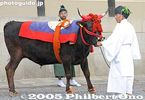
The bull was mooing all the time and was very restless.Do bulls moo or do they snort? This was making a loud noise.
|
|

Norijiri horseman leads the procession. 乗尻The procession, called Roto-no-Gi (路頭の儀), is actually one of three rites performed during the festival.
|
|

Norijiri horseman leads the procession. 乗尻
|
|

10:30 am: Starting point at Kyoto Gosho Imperial Palace 京都御所 出発The procession is ready to depart.
|
|

Everyone is dressed in Heian-Period (794-1185) costumes.
|
|

No. 4 official of the old police force and court justice called Kebiishi-no-sakan 検非違使志検非違使志
|
|
|
|
|

No. 3 official of the old police force and court justice called Kebiishi-no-jo 検非違使尉検非違使尉
|
|

The procession basically consists of two columns: The Hon-retsu which includes the procession's highest-ranking official called Chokushi. It consists of men. The second and longer column is the Saio-dai-retsu consisting of women.
|
|
|

"Heian" comes from "Heian-kyo," the former name of Kyoto city.
|
|

The Heian Period was when Kyoto was the capital of Japan where the Emperor resided.
|
|
|
|

The Aoi Matsuri (Festival) used to be called Kamo-sai, after the name of the two shrines which hold the festival.賀茂祭
|
|
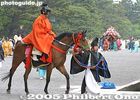
One of six court dancers called maibito. 舞人
|
|

The procession's highest-ranking official called Chokushi. An Imperial Messenger. The horse is highly decorated. 勅使
|
|

The Aoi Matsuri started in the early Heian Period in the 8th century as a national or state-sponsored event.
|
|

May 15, the day of the procession, is the festival's climax. However, there are other festival-related ceremonies and events before this day.
|
|

Over 500 people in the procession walk along the 8-kilometer route.There's a lunch break at around noon at Shimogamo Shrine.
|
|
|

Flower umbrella called furyu-gasa. 風流傘Flowers are artificial.
|
|

Musician called baiju. There are seven of them wearing the same wardrobe. 陪従
|
|
|

Flower umbrella
|
|

Saio-dai Princess procession. 斎王代
|
|

Saio-dai Princess procession. 斎王代
|
|

The Saio-dai Retsu column begins. Consists of all women, highlighted by the Saio-dai Princess.
|
|

High-ranking lady of the court
|
|

Court ladies called myobu. 命婦
|
|

Court lady called myobu. 命婦
|
|

Court lady called myobu. 命婦
|
|
|
|
|
|
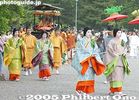
斎王代
|
|

Saio-dai Princess riding on a special palanquin called Oyoyo. 斎王代 腰輿(およよ)腰輿(およよ)
|
|
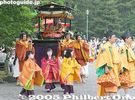
The Saio-dai Princess in 2005 was Saito Ayako, a 21-year-old Kyoto native and student at Doshisha Univ. Her 12-layer juni-hitoe kimono weighs 30 kg. 斎王代、齋藤彩子さん(21)The Saio-dai Princess is selected every year in April and a press conference is held to announce who was chosen. She is always a native of Kyoto, single, and in her early 20s. The Saio-dai was first incorporated in the festival in 1956. In 2005, she is the 50th Saio-dai.
Read more about here.
|
|

The Saio-dai Princess is the main figure of the procession. She represents the Imperial princess who worked at the Kamo Shrine and served in the Aoi Festival during the Heian Period.腰輿(およよ)
|
|
|

Court ladies called uneme. Their kimono have a blue wave design. 釆女釆女
|
|

Shrine maiden on horseback called Munanori Onna. 騎女They escort the Saio-dai Princess.
|
|

Shrine maiden on horseback called Munanori Onna. They escort the Saio-dai Princess.騎女
|
|

Shrine maiden on horseback called Munanori Onna.騎女
|
|

Shrine maiden on horseback called Munanori Onna.騎女
|
|

Shrine maiden on horseback called Munanori Onna.騎女
|
|

With over 30 horses in the procession, this guy will be kept busy...
|
|

Following the Saio-dai Princess are more high-ranking ladies of the court.
|
|
|
|
|
|
|
|
|

The procession is about 1 kilometer long.Wall of Kyoto Imperial Palace.
|
|
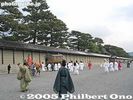
It takes about an hour to see the entire procession go by.Wall of Kyoto Imperial Palace.
|
|

Main promenade of Kyoto Imperial Palace
|
|
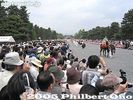
Main promenade of Kyoto Imperial PalaceUnless you get here early, it is very difficult to get a good place to take pictures. This promenade is the most popular place for photographers. It is most scenic because there are no distracting buildings.
|
|
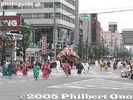
Kawaramachi-dori 河原町通
|
|

Kawaramachi-dori 河原町通
|
|
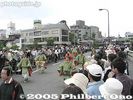
Bridge to Shimogamo Shrine 出町橋
|
|

Hollyhock (aoi) leaves 葵
|
|

11:50 am: The procession reaches Shimogamo Shrine. 下鴨神社Shimogamo Shrine has a very elongated shrine grounds, with a long straight path to the shrine hall.
糺の森(ただすのもり)
|
|

Saio-dai Princess passing through Shimogamo Shrine's Tadasu no Mori forest promenade. 斎王代、糺の森(ただすのもり)にて下鴨神社
糺の森(ただすのもり)
|
|

Ceremony at Shimogamo Shrine. 下鴨神社The public is not allowed to see the ceremony within the shrine.
|
|

Horse track at Shimogamo Shrine. 下鴨神社
|
|

They have several horses running down the track at full speed. 下鴨神社
|
|
|

This good horse stopped as signaled. But a few other horses just galloped past without stopping.下鴨神社
|
|

The procession departed Shimogamo Shrine at 2:20 pm to head for Kamigamo Shrine up river. People here waiting for the procession along the Kamogawa River. 鴨川沿いの加茂街道鴨川沿いの加茂街道
|
|

About 3:00 pm: The start of the procession begins with a police car.鴨川沿いの加茂街道
|
|

And mounted police.
|
|
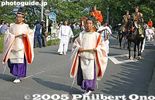
Norijiri horsemen. 乗尻
|
|

Norijiri horsemen leads the procession. 乗尻
|
|
|
|
|
|
|
|
|
|
|
|
|
|
|
|
|
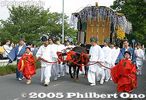
The first ox carriage. 牛車
|
|

Ox carriage decorated with purple wisteria flowers.
|
|

The wooden wheels creak like they did centuries ago.
|
|
|
|
|

One of six court dancers called maibito. 舞人
|
|

One of six court dancers called maibito. 舞人
|
|

The procession's highest-ranking official called Chokushi. An Imperial Messenger. 勅使
|
|

The procession's highest-ranking official called Chokushi. An Imperial Messenger. 勅使
|
|
|

Flower umbrella called furyu-gasa. 風流傘These flower umbrellas are mainly for decorative purposes, to add more color to the procession.
|
|
|
|
|
|

Flower umbrellaThese flower umbrellas are mainly for decorative purposes, to add more color to the procession.
|
|

Flower umbrellaThese flower umbrellas are mainly for decorative purposes, to add more color to the procession.
|
|

High-ranking Lady of the Court 高級女官高級女官
|
|

High-ranking Lady of the Court高級女官
|
|
|
|
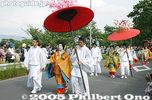
High-ranking Lady of the Court 高級女官
|
|
|

Kawaii!!
|
|

斎王代、齋藤彩子さん(21)
|
|

She wears a juni-hitoe kimono and rides in a carriage called Oyoyo. 斎王代、齋藤彩子さん (21)腰輿(およよ)
|
|
|
|
|

Court ladies called uneme. Their kimono have a blue wave design. 釆女
|
|

Shrine maiden on horseback called Munanori Onna. 騎女
|
|

Shrine maiden on horseback called Munanori Onna. 騎女
|
|

Shrine maiden on horseback called Munanori Onna.
|
|

Shrine maiden on horseback called Munanori Onna.
|
|

Shrine maiden on horseback called Munanori Onna.
|
|

Shrine maiden on horseback called Munanori Onna.
|
|

High-ranking court lady
|
|
|
|

女別当
|
|

The Saio-dai's ox carriage called a gissha. 牛車
|
|

The ox carriage's traditional entourage includes a carpenter who repairs the carriage during the procession if necessary.最高位の女官が乗る女房車という牛車
|
|

Ox carriage with plum blossoms dangling from the roof.
|
|
|

Procession crossing over the Kamogawa River on the Misonobashi Bridge to Kamigamo Shrine. 御薗橋
|
|

3:30 pm: The procession reaches Kamigamo Shrine. 上賀茂神社
|
|

Kamigamo Shrine 上賀茂神社
|
|
|

Horses going to the starting point to run down the track between the two toriis at Kamigamo Shrine.
|
|
|

Capping the festival is this horse running at Kamigamo Shrine. 走馬
|
|

走馬
|
|

Whoa!
|
|

All finish
|
|

Long line for the bus stop.
|
|

Line at the bus stop. The buses did not come so frequently. So I just walked back to the nearest subway station.
|
|
|
|
|
|